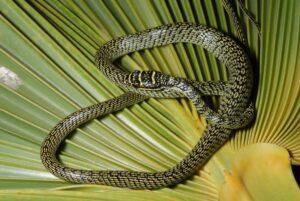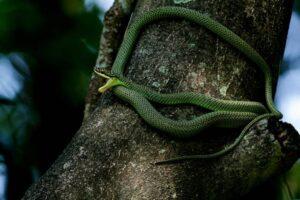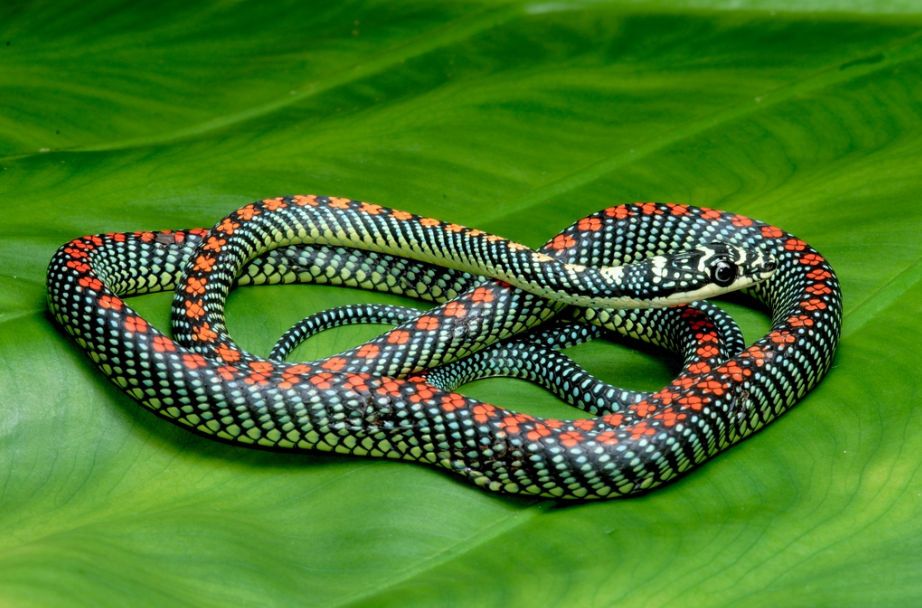The golden tree snake is variously called ornate flying snake, gliding snake, golden flying snake, flying tree snake, and gold and black tree snake. Some of its common names owe to its unique capability of a type of gliding flight that it uses to quickly escape predators, move around in forests and catch prey.
Scientific Classifications
- Suborder:Serpentes
- Family:Colubridae
- Genus:Chrysopelea
- Species:C. ornata
Conservation Status
Subspecies
This snake has three recognized subspecies.
- Chrysopelea ornata ornata
- Chrysopelea ornata ornatissima
- Chrysopelea ornata sinhalea
Description
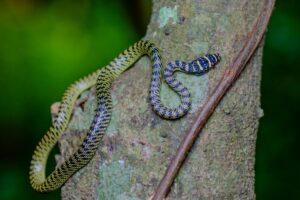
Size
The snake measures 0.38-4.27 ft (11.5-130 cm) in length, with its tail making up a quarter of its total length.
Color and Appearance
The colubrid is usually green with black cross-hatching and gold or yellow accents. Its head is flat with a blunt nose and big eyes having round pupils. Its neck is constricted. An identifying feature is its lateral, sharp, and prominently keeled ventrals combined with a regular, un-enlarged vertebral row of scales.
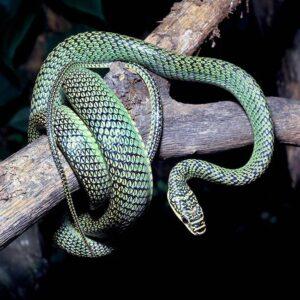
It can have 2 major color variants found throughout its range. In Southern India and Sri Lanka, its color is pale green or greenish yellow. Each scale has a black mesial spot or streak and has a more or less black outline. It has dark crossbars at specific intervals and may have a series of orange or reddish flower-shaped vertebral spots. The greenish ventrals are edged with black or spots on the outer side of the keels. The black head has yellow spots and crossbars.
The variants in south-east Asia lack the reddish vertebral spots and have less pronounced black crossbars. Everything else remains almost the same.
Are They Dangerous to Humans
The fast-moving colubrids have a nervous nature causing them to flee when disturbed. But they usually don’t hesitate to bite on being handled. Their venom is mild and can’t pose any danger to humans.
Golden Tree Snakes at a Glance
Distribution
Ornate flying snakes occur in India (from the Western Ghats to the Dangs, north Bihar, Katernia Ghat in Uttar Pradesh, north of West Bengal, eastwards up to Arunachal Pradesh, and the forests of Andaman), Bangladesh, Thailand, Myanmar, Laos, Cambodia, Vietnam, western Malaysia, China (Hainan, Hong Kong, Yunnan), Indonesia (Borneo, Java, Sumatra, Sulawesi), and the Philippines.
Habitat
They live in rainforests, plantations, and dry deciduous forests and are also well adapted to human habitats.
Their gliding ability allows them to move from one tree to another easily. The excellent climbers can move across the smallest of branches and straight up trees with sparse branches.
Lifespan
Their lifespan ranges from 4 to 12 years.
Predators
They can be eaten by kraits and king cobras if they manage to catch them.
Diet
They feed on small arboreal creatures like lizards, small rodents, and bats. They may also eat insects and bird eggs. It occasionally takes snakes and mostly avoids frogs.
The golden tree snake pursues its prey before seizing it by its neck and crushing it with its strong jaws.
Reproduction
Oviparous (lays eggs that hatch outside the body)
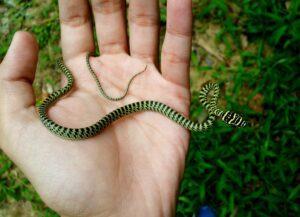
A gravid female lays 6-12 elongated eggs in May and June. The eggs hatch in June, with the hatchlings measuring 4.5-6” (114-152 mm). They reach maturity when they are typically 3.3 ft (1 m) long.
Source
hdoa.hawaii.gov, thainationalparks.com, monaconatureencyclopedia.com, factanimal.com, live.staticflickr.com

